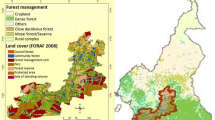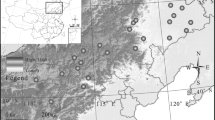Abstract
Soil and foliar analysis were used to investigate influence of edaphic and climatic factors on the soil–plant nutrient dynamics in Uapaca kirkiana dominated woodland ecosystem in Zimbabwe. Examination of the relationship between soil factors and foliar nutrient concentrations as analysed by multiple regression analysis showed that between 60 and 97% of the variations in foliar nutrient concentrations during the wet period, with the exception of nitrogen, could be explained by soil factors: soil nutrient content, texture and pH. In the dry winter period, influence of these soil factors on foliar nutrient content was in the range between 48 and 97%. Factors that had significant influence (P < 0.05) were particularly exhibited during the wet period and these were those influencing foliar P, Fe, Mn and Zn. Multiple regression analysis between climatic factors and foliar nutrients showed temperature had a statistically significant negative relationship with Fe whilst precipitation had a highly significant positive relationship with Fe during the dry winter period. Correlation between foliar Fe and rainfall was negatively statistically significant during the rainy period (P < 0.05) and became positively statistically highly significant during the dry period (P < 0.01). There was also a highly statistically significant negative relationship between the total annual rainfall and foliar nitrogen during the dry winter period. Findings of the study highlight importance of both soil and climatic factors on soil–plant nutrient dynamics in the miombo ecosystem, and should therefore be taken into consideration when establishing U. kirkiana in an agroforestry system.

Similar content being viewed by others
References
Atlas MR, Bartha R (1987) Microbial ecology: fundamentals and applications. Benjamin/Cummings Publishing Company, Menlo Park
Boaler SB (1966) Plant communities and seasonal variation in the vegetation. J Ecol 54:465–479
Chidumayo EN (1997) Miombo ecology and management. An introduction. Intermediate Technology Publications, London, pp 30–31
Colak A, Kolcuoglu Y, Sesli E, Dalman O (2007) Biochemical composition of some Turkish fungi. Asian J Chem 19:2193–2199
Cumming JR (1996) Phosphate-limitation physiology in ectomycorrhizal pitch pine (Pinus rigida) seedlings. Tree Physiol 16:977–983
Ellis F (1999) Iron, the first of six micro-nutrients. Wood SA and Timber Times, Auckland Park, pp 10–11
Högberg P (1982) Mycorrhizal association in some woodland and forest trees and shrubs in Tanzania. New Phytol 92:407–415
Högberg P (1986a) Nitrogen fixation and nutrient relations in savanna woodland trees (Tanzania). J Appl Ecol 23:675–688
Högberg P (1986b) Soil nutrient availability, root symbiosis and tree species composition in tropical Africa (A review). J Trop Ecol 2:359–372
Jeutschke G, Brandes B, Kuhn A, Schroder WH, Becker JS, Goldbold DL (2000) The mycorrhizal fungus Paxillus involutus transports magnesium to Norway spruce seedlings. Evidence from stable isotope labelling. Plant Soil 220:243–246
Jonasson S, Michelsen A, Schmidt IK, Nielsen EV (1999) Responses in microbes and plants to changed temperature, nutrient, and light regimes in the Arctic. Ecology 80:1828–1843
Kottke I, Pargney JC, Qian XM, Disquet I (1995) Passage and deposition of solutes in the hyphal sheath of ectomycorrhizas-the soil-root interface. Contribution to forest tree physiology. Institut National de la Recherche Agronomique (INRA), Paris, pp 255–271
Mwamba CK (1994) Variations in fruits of Uapaca kirkiana and effects of in situ silvicultural treatments on fruit parameters. In: Paper presented at the Regional Conference on potential for improvement of indigenous fruit trees of the miombo woodlands of Southern Africa, Mangochi, Malawi, 23–27 January 1994
Mwamba CK, Zgambo Y, Chongo G (1992) Effect of seedling source on post-planting growth of Uapaca kirkiana Muell. Arg. S Afr For J 161:35–40
Nealson KH (1983) The microbial iron cycle. In: Krumbein WE (ed) Microbial geochemistry. Blackwell Scientific Publications, Oxford, pp 159–190
Nyamapfende K (1991) Soils of Zimbabwe. Nehanda Publishers, Harare
Piearce GD (1988) Mushrooms for pleasure and profit. Research note No. 41, Division of Forest Research. Kitwe, Zambia, pp 30–32
Schönau APG (1981) The effects of fertilising on the foliar nutrients concentrations in Eucalyptus grandis. Fertil Res 2:73–87
Sesli E (2007) Trace metal content of higher fungi from Zigana Highland in Turkey. Asian J Chem 19:636–640
Slankis V (1974) Soil factors influencing formation of mycorrhizae. Ann Rev Phytopathol 12:437–457
Stihi C, Radulescu C, Busuioc G, Popescu IV, Gheboianu A, Ene A (2009) Studies on accumulation of heavy metals from substrate to edible wild mushroom. Romanian J Physiol 56(1–2):257–264
Terry N, Low G (1982) Leaf chlorophyll content and its relation to the intracellular localization of iron. J Plant Nutr 5:301–310
Vetter J, Siller I, Horvath Z (1997) Zinc content of sporocarps of basidiomycetous fungi. Mycologia 89:481–483
Wallander H, Wickman T (1999) Biotite and microcline as potassium sources in ectomycorrhizal and non-mycorrhizal Pinus sylvestris seedlings. Mycorrhiza 9:25–32
Yeşil ÖF, Yildiz Ö (2004) Level of heavy metals in some edible and poisonous macrofungi of Diyarbakir region in Turkey. Bull Environ Contam Toxicol 73:853–861
Acknowledgements
The study was funded by African Academy of Sciences.
Author information
Authors and Affiliations
Corresponding author
Rights and permissions
About this article
Cite this article
Ramachela, K. Edaphic and climatic factors and the nutrient dynamics in Uapaca kirkiana dominated miombo woodland agroforestry ecosystems. Agroforest Syst 93, 1501–1511 (2019). https://doi.org/10.1007/s10457-018-0256-0
Received:
Accepted:
Published:
Issue Date:
DOI: https://doi.org/10.1007/s10457-018-0256-0




